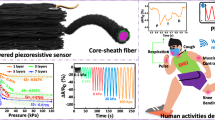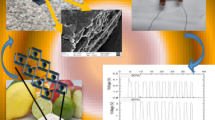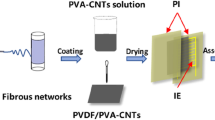Abstract
Wearable electronic devices have attracted extensive attention for their potential applications in robotic haptics, human-computer interaction, and human pulse wave measurement. A flexible pressure sensor, as a wearable electronic device, should be environmentally friendly and low-cost to manufacture. Cellulose paper-based pressure sensors have attracted much attention due to their excellent properties such as light weight, no or low toxicity, degradability, and flexibility. Here, we report a strategy for piezoresistive tactile sensors based on indium tin oxide (ITO) nanocrystal and plant fiber composite. The pressure sensor has a wide detection range (0–100 kPa), high sensitivity (464.88 kPa−1), fast response time (6.93 ms) and recovery time (7.18 ms), and good loading and unloading stability. We also demonstrate that the as-prepared pressure sensors can be used for pulse testing, respiration monitoring, voice recognition, and various human motion detections. The results show that the pressure sensor based on the ITO nanocrystalline-plant fiber composite has the prospect of being applied to smart wearable electronic products.

摘要
可穿戴电子设备因其在机器人触觉、 人机交互和脉搏测试等领域具有潜在应用而引起广泛关注. 作为一种可穿戴电子设备, 柔性压力传感器应该是环保的, 而且制造成本低. 基于纤维素纸的压力传感器由于其优良的特性, 如轻质、 无毒或低毒、 可降解性和柔韧性, 而引起了人们的关注. 在此, 我们报道了一种基于铟锡氧化物(ITO)纳米晶体和植物纤维复合材料的电阻式触觉传感器. 该压力传感器具有宽的检测范围(0–100 kPa)、 高灵敏度(464.88 kPa−1)、 快速的响应时间(6.93 ms)和恢复时间(7.18 ms)以及良好的加载/卸载稳定性. 我们还展示了该压力传感器用于脉搏测试、 呼吸监测、 语音识别等各种人体运动检测. 结果表明, ITO纳米晶-植物纤维复合材料压力传感器在智能可穿戴电子产品中显示出巨大应用潜力.
Similar content being viewed by others
References
Wang FX, Wang MJ, Liu HC, et al. Multifunctional self-powered e-skin with tactile sensing and visual warning for detecting robot safety. Adv Mater Interfaces, 2020, 7: 2000536
Chang TH, Tian Y, Li C, et al. Stretchable graphene pressure sensors with Shar-Pei-like hierarchical wrinkles for collision-aware surgical robotics. ACS Appl Mater Interfaces, 2019, 11: 10226–10236
Guo Y, Guo Z, Zhong M, et al. A flexible wearable pressure sensor with bioinspired microcrack and interlocking for full-range human-machine interfacing. Small, 2018, 14: 1803018
Zhao Y, Liu L, Li Z, et al. Facile fabrication of highly sensitive and durable cotton fabric-based pressure sensors for motion and pulse monitoring. J Mater Chem C, 2021, 9: 12605–12614
Lin X, Zhang T, Cao J, et al. Flexible piezoresistive sensors based on conducting polymer-coated fabric applied to human physiological signals monitoring. J Bionic Eng, 2020, 17: 55–63
Lin X, Gao S, Fei T, et al. Study on a paper-based piezoresistive sensor applied to monitoring human physiological signals. Sens Actuat A-Phys, 2019, 292: 66–70
Guo Y, Yin F, Li Y, et al. Incorporating wireless strategies to wearable devices enabled by a photocurable hydrogel for monitoring pressure information. Adv Mater, 2023, 35: 2300855
Shu J, Gao L, Li Y, et al. MXene/tissue paper composites for wearable pressure sensors and thermotherapy electronics. Thin Solid Films, 2022, 743: 139054
Tan Y, Ivanov K, Mei Z, et al. A soft wearable and fully-textile piezoresistive sensor for plantar pressure capturing. Micromachines, 2021, 12: 110
Li L, Fu X, Chen S, et al. Hydrophobic and stable MXene-polymer pressure sensors for wearable electronics. ACS Appl Mater Interfaces, 2020, 12: 15362–15369
Guo Y, Li H, Li Y, et al. Wearable hybrid device capable of interactive perception with pressure sensing and visualization. Adv Funct Mater, 2022, 32: 2203585
Sakhuja N, Kumar R, Katare P, et al. Structure-driven, flexible, multi-layered, paper-based pressure sensor for human-machine interfacing. ACS Sustain Chem Eng, 2022, 10: 9697–9706
Yang J, Li H, Cheng J, et al. Nanocellulose intercalation to boost the performance of MXene pressure sensor for human interactive monitoring. J Mater Sci, 2021, 56: 13859–13873
Xu Y, Sun B, Ling Y, et al. Multiscale porous elastomer substrates for multifunctional on-skin electronics with passive-cooling capabilities. Proc Natl Acad Sci USA, 2020, 117: 205–213
Choi S, Yoon K, Lee S, et al. Conductive hierarchical hairy fibers for highly sensitive, stretchable, and water-resistant multimodal gesturedistinguishable sensor, VR applications. Adv Funct Mater, 2019, 29: 1905808
Niu H, Li H, Li Y, et al. Cocklebur-inspired “branch-seed-spininess” 3D hierarchical structure bionic electronic skin for intelligent perception. Nano Energy, 2023, 107: 108144
Niu H, Li H, Gao S, et al. Perception-to-cognition tactile sensing based on artificial-intelligence-motivated human full-skin bionic electronic skin. Adv Mater, 2022, 34: 2202622
Huang H, Shao R, Wang C, et al. Flexible, ultralight, ultrathin, and highly sensitive pressure sensors based on bacterial cellulose and silver nanowires. J Mater Sci, 2022, 57: 20987–20998
Fu D, Wang R, Wang Y, et al. An easily processable silver nanowires-dual-cellulose conductive paper for versatile flexible pressure sensors. Carbohydrate Polyms, 2022, 283: 119135
Cai B, Wang L, Yu F, et al. Compressible piezoresistive pressure sensor based on Ag nanowires wrapped conductive carbonized melamine foam. Appl Phys A, 2022, 128: 6
Chen T, Wu G, Panahi-Sarmad M, et al. A novel flexible piezoresistive sensor using superelastic fabric coated with highly durable SEBS/TPU/CB/CNF nanocomposite for detection of human motions. Compos Sci Tech, 2022, 227: 109563
Huang L, Chen J, Xu Y, et al. Three-dimensional light-weight piezoresistive sensors based on conductive polyurethane sponges coated with hybrid CNT/CB nanoparticles. Appl Surf Sci, 2021, 548: 149268
Meng J, Pan P, Yang Z, et al. Degradable and highly sensitive CB-based pressure sensor with applications for speech recognition and human motion monitoring. J Mater Sci, 2020, 55: 10084–10094
Hur ON, Ha JH, Park SH. Strain-sensing properties of multi-walled carbon nanotube/polydimethylsiloxane composites with different aspect ratio and filler contents. Materials, 2020, 13: 2431
Michel TR, Capasso MJ, Cavusoglu ME, et al. Evaluation of porous polydimethylsiloxane/carbon nanotubes (PDMS/CNTs) nanocomposites as piezoresistive sensor materials. Microsyst Technol, 2020, 26: 1101–1112
Ma L, Lei X, Li S, et al. A 3D flexible piezoresistive sensor based on surface-filled graphene nanosheets conductive layer. Sens Actuat A-Phys, 2021, 332: 113144
Yao W, Mao R, Gao W, et al. Piezoresistive effect of superelastic graphene aerogel spheres. Carbon, 2020, 158: 418–425
Riyajuddin S, Kumar S, Gaur SP, et al. Linear piezoresistive strain sensor based on graphene/g-C3N4/PDMS heterostructure. Nanotechnology, 2020, 31: 295501
Liu W, Liu N, Yue Y, et al. Piezoresistive pressure sensor based on synergistical innerconnect polyvinyl alcohol nanowires/wrinkled graphene film. Small, 2018, 14: 1704149
Cheng H, Zhang N, Yin Y, et al. A high-performance flexible piezoresistive pressure sensor features an integrated design of conductive fabric electrode and polyurethane sponge. Macromol Mater Eng, 2021, 306: 2100263
Huang CB, Witomska S, Aliprandi A, et al. Molecule-graphene hybrid materials with tunable mechanoresponse: Highly sensitive pressure sensors for health monitoring. Adv Mater, 2019, 31: 1804600
Zhang Z, Weng L, Guo K, et al. Durable and highly sensitive flexible sensors for wearable electronic devices with PDMS-MXene/TPU composite films. Ceramics Int, 2022, 48: 4977–4985
Zhang H, Sun X, Hubbe M, et al. Flexible and pressure-responsive sensors from cellulose fibers coated with multiwalled carbon nanotubes. ACS Appl Electron Mater, 2019, 1: 1179–1188
Cho SY, Yu H, Choi J, et al. Continuous meter-scale synthesis of weavable tunicate cellulose/carbon nanotube fibers for high-performance wearable sensors. ACS Nano, 2019, 13: 9332–9341
Liu H, Xiang H, Li Z, et al. Flexible and degradable multimodal sensor fabricated by transferring laser-induced porous carbon on starch film. ACS Sustain Chem Eng, 2019, 8: 527–533
Hou C, Xu Z, Qiu W, et al. A biodegradable and stretchable protein-based sensor as artificial electronic skin for human motion detection. Small, 2019, 15: 1805084
Gogurla N, Roy B, Park JY, et al. Skin-contact actuated single-electrode protein triboelectric nanogenerator and strain sensor for biomechanical energy harvesting and motion sensing. Nano Energy, 2019, 62: 674–681
Bethke K, Palantöken S, Andrei V, et al. Functionalized cellulose for water purification, antimicrobial applications, and sensors. Adv Funct Mater, 2018, 28: 1800409
Huang H, Dong Y, Wan S, et al. A transient dual-type sensor based on MXene/cellulose nanofibers composite for intelligent sedentary and sitting postures monitoring. Carbon, 2022, 200: 327–336
Yang L, Wang H, Yuan W, et al. Wearable pressure sensors based on MXene/tissue papers for wireless human health monitoring. ACS Appl Mater Interfaces, 2021, 13: 60531–60543
Koga H, Nagashima K, Huang Y, et al. Paper-based disposable molecular sensor constructed from oxide nanowires, cellulose nanofibers, and pencil-drawn electrodes. ACS Appl Mater Interfaces, 2019, 11: 15044–15050
Liu H, Wang W, Xiang H, et al. Paper-based flexible strain and pressure sensor with enhanced mechanical strength and super-hydrophobicity that can work under water. J Mater Chem C, 2022, 10: 3908–3918
Tao LQ, Zhang KN, Tian H, et al. Graphene-paper pressure sensor for detecting human motions. ACS Nano, 2017, 11: 8790–8795
Yang Y, Shen H, Yang Z, et al. Highly flexible and sensitive wearable strain and pressure sensor based on porous graphene paper for human motion. J Mater Sci-Mater Electron, 2022, 33: 17637–17648
Qi X, Li X, Jo H, et al. Mulberry paper-based graphene strain sensor for wearable electronics with high mechanical strength. Sens Actuat A-Phys, 2020, 301: 111697
Lee DJ, Kim DY. Paper-based, hand-painted strain sensor based on ITO nanoparticle channels for human motion monitoring. IEEE Access, 2019, 7: 77200–77207
Duan Z, Jiang Y, Huang Q, et al. Facilely constructed two-sided microstructure interfaces between electrodes and cellulose paper active layer: Eco-friendly, low-cost and high-performance piezoresistive sensor. Cellulose, 2021, 28: 6389–6402
Zhao P, Zhang R, Tong Y, et al. All-paper, all-organic, cuttable, and foldable pressure sensor with tuneable conductivity polypyrrole. Adv Electron Mater, 2020, 6: 1901426
Kannichankandy D, Pataniya PM, Narayan S, et al. Flexible piezoresistive pressure sensor based on conducting PANI on paper substrate. Synth Met, 2021, 273: 116697
Su T, Liu N, Lei D, et al. Flexible MXene/bacterial cellulose film sound detector based on piezoresistive sensing mechanism. ACS Nano, 2022, 16: 8461–8471
Su T, Liu N, Gao Y, et al. MXene/cellulose nanofiber-foam based high performance degradable piezoresistive sensor with greatly expanded interlayer distances. Nano Energy, 2021, 87: 106151
Selamneni V, Kunchur A, Sahatiya P. Large-area, flexible SnS/paper-based piezoresistive pressure sensor for artificial electronic skin application. IEEE Sens J, 2021, 21: 5143–5150
Huang Y, Wang Z, Zhou H, et al. Highly sensitive pressure sensor based on structurally modified tissue paper for human physiological activity monitoring. J Appl Polym Sci, 2020, 137: 48973
Acknowledgements
This work was financially supported by the National Natural Science Foundation of China (11874267 and 51373036) and the National Science Foundation for Young Scientists of China (61704107).
Author information
Authors and Affiliations
Contributions
Author contributions Xia Y designed and participated in the whole project; Huang P fabricated and measured the samples; Lin X, Wu L, and Li K characterized the devices; Gao C fabricated the devices; Huang P and Zhong G wrote and revised the manuscript. All authors contributed to the general discussion.
Corresponding author
Ethics declarations
Conflict of interest The authors declare that they have no conflict of interest.
Additional information
Yijie Xia is a professor at the University of Shanghai for Science and Technology. She received her PhD degree from the National University of Singapore. Her research interest focuses on flexible optoelectronic materials and devices.
Pengju Huang is a graduate student under the supervision of Assoc. Prof. Yijie Xia at the University of Shanghai for Science and Technology and Assoc. Prof. Gaoyu Zhong at Fudan University. His research interest focuses on flexible pressure sensors.
Rights and permissions
About this article
Cite this article
Xia, Y., Huang, P., Lin, X. et al. The piezoresistive pressure sensors based on ITO nanocrystalline-plant fiber composite. Sci. China Mater. 66, 3922–3930 (2023). https://doi.org/10.1007/s40843-023-2534-1
Received:
Accepted:
Published:
Issue Date:
DOI: https://doi.org/10.1007/s40843-023-2534-1




